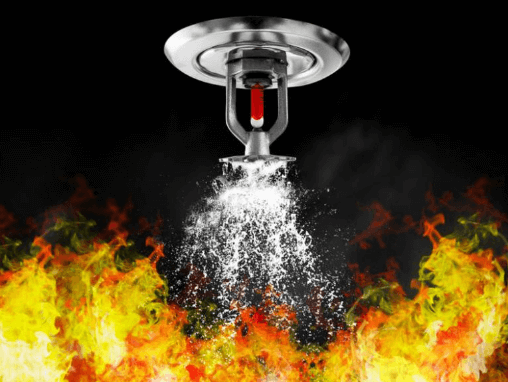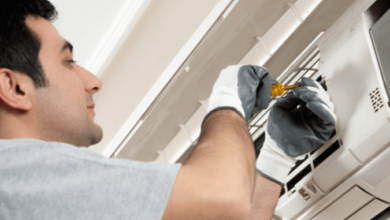Fire Sprinkler Systems

Fire sprinkler systems are essential active fire protection mechanisms designed to automatically detect and suppress fires in buildings. According to the National Fire Sprinkler Network UK, these systems have demonstrated high effectiveness, with no recorded fire deaths in buildings equipped with properly maintained sprinklers, along with a 99% success rate in controlling or extinguishing fires.
Early Suppression Fast Response
Early Suppression Fast Response (ESFR) sprinkler systems are specifically designed to rapidly suppress fires in high-challenge environments, such as warehouses with high-piled storage by companies such as QSD Fire. Unlike conventional sprinklers that focus on controlling fires, ESFR systems aim to extinguish fires quickly. Key features of ESFR systems include:
- High water flow rates of up to 100 gallons per minute, compared to 25-30 gallons for standard sprinklers
- Large water droplet size and high discharge velocity for effective fire plume penetration
- Quick activation due to fast-response elements
- Protection for storage heights up to 40 feet and building heights up to 45 feet
- Potential elimination of in-rack sprinklers, reducing installation costs and providing more flexible storage
ESFR systems are particularly beneficial in warehouses, distribution centers, and manufacturing facilities where rapid fire suppression is crucial for minimizing property damage and protecting high-value goods.
Foam Water Sprinkler Systems
Foam water sprinkler systems are specialized fire protection installations that combine water with foam concentrate to extinguish fires involving flammable liquids or other high-challenge hazards. These systems discharge a foam-water mixture, creating a blanket of foam that helps by:
- Cooling the fuel and surrounding area
- Separating the fuel from oxygen
- Suppressing flammable vapors to prevent re-ignition
Typically used in high-hazard areas like aircraft hangars, chemical storage facilities, and power plants, foam water systems can operate as wet pipe, dry pipe, or deluge configurations. The foam concentrate is generally stored separately and injected into the water flow upon system activation, with the foam mixture then distributed through specially designed foam-water sprinklers.
SMART Sprinkler Technology
SMART sprinkler technology represents a significant advancement in fire protection systems, combining rapid detection, precise fire location identification, and targeted suppression. These systems use multiple sensors, including smoke detectors and temperature sensors, to quickly identify and pinpoint fires. Key features of SMART sprinkler systems include:
- Faster activation, detecting fires with flames as low as 10 feet compared to the 40 feet required by traditional sprinklers
- Coordinated activation of multiple sprinklers around the fire origin
- Reduced water usage, potentially lowering water demand by over 50% and reducing fire and smoke damage
- Integration with other fire safety systems through smart technology platforms for centralized monitoring and control
SMART sprinkler systems offer advantages for protecting high-value products and areas with limited water resources, making them an effective solution for modern warehouses and storage facilities.
Deluge Foam Systems
Deluge foam systems are specialized fire protection installations that provide rapid response in high-hazard areas where flammable liquids or fast-spreading fires pose significant risks. These systems feature open sprinkler heads or nozzles that discharge a foam-water mixture over the entire protected area when activated. Key characteristics of deluge foam systems include:
- Immediate, full-area coverage upon activation, providing a foam blanket for rapid fire suppression
- Activation through automatic detection systems or manual release
- Common use in high-risk areas such as aircraft hangars, chemical storage facilities, and power plants
- Compatibility with various foam concentrates, including alcohol-resistant foams for specific hazards
- A typical design density of at least 6.5 mm/m² (0.16 gpm/ft²) with a minimum 10-minute discharge duration
Deluge foam systems are especially effective in situations where water-based systems alone might be insufficient, offering enhanced fire control and suppression for high-risk environments.
High-Pressure Water Mist
High-pressure water mist systems operate at pressures between 70 to 200 bar, creating extremely fine water droplets that efficiently suppress fires. These systems work by addressing two elements of the fire triangle: oxygen and heat. The tiny droplets rapidly evaporate when exposed to fire, absorbing significant energy and displacing oxygen, leading to fast fire suppression. Key benefits of high-pressure water mist systems include:
- Rapid fire suppression with minimal water usage, typically using only 10% of the water required by traditional sprinkler systems
- Reduced water damage to property and assets
- Effective cooling of the surrounding area, preventing re-ignition
- Reduction of smoke and soot particles, improving visibility and air quality during a fire
- Versatility for a range of applications, including industrial settings, historic buildings, and data centers
High-pressure water mist systems are particularly valuable in settings where water damage is a concern or water resources are limited, offering an efficient and environmentally friendly fire suppression solution.
Pre-Action Sprinkler Systems
Pre-action sprinkler systems are specialized fire protection systems designed for water-sensitive environments where accidental discharge could cause significant damage. These systems require a two-step activation process, offering extra protection against false alarms. In a pre-action system, the pipes remain dry until a fire is detected, at which point they fill with water, ready for discharge if a sprinkler head activates. Key features include:
- Dual activation requirement: fire detection system trigger and individual sprinkler head activation
- Reduced risk of accidental water damage
- Ideal for data centers, museums, libraries, and cold storage facilities
- Available in single and double interlock configurations for added security
- Higher installation and maintenance costs compared to traditional systems
- Excellent performance in extremely cold environments due to dry pipes
Pre-action systems offer a balance between fire protection and asset preservation, making them a preferred choice for safeguarding valuable or sensitive equipment and materials.
Dry Pipe Systems
Dry pipe sprinkler systems are designed for areas where freezing temperatures could render traditional wet pipe systems inoperable. In these systems, pipes are filled with pressurized air or nitrogen instead of water. Key features of dry pipe systems include:
- Activation occurs when a sprinkler head opens, releasing the pressurized air and allowing water to flow into the pipes
- Commonly used in unheated buildings, parking garages, and refrigerated spaces
- Delayed water delivery of up to 60 seconds compared to wet pipe systems
- Increased complexity and maintenance due to components like air compressors and dry pipe valves
- Limited to a maximum system volume (typically 750 gallons) to ensure timely water delivery
- Higher installation and maintenance costs than wet pipe systems
Dry pipe systems offer effective protection in cold environments but are generally not recommended for high-hazard storage applications due to the delayed water delivery.
Read also: Emergency Plumbers in Tring: Plumbing Services in Tring
Remote Monitoring Capabilities
Remote monitoring capabilities in smart sprinkler systems allow for efficient management of fire protection resources and real-time oversight from virtually anywhere. These systems typically include:
- Real-time data on system status, temperature, pressure, and flow rates
- GPS location tracking of critical components
- Mobile app interfaces for remote control and scheduling
- Automated alerts for abnormal conditions or equipment malfunctions
- Historical data logging for trend analysis and optimization
By providing continuous visibility into fire protection systems, remote monitoring enables property managers and safety personnel to make data-driven decisions, reduce risks, and improve response times while minimizing labor costs associated with manual inspections.




